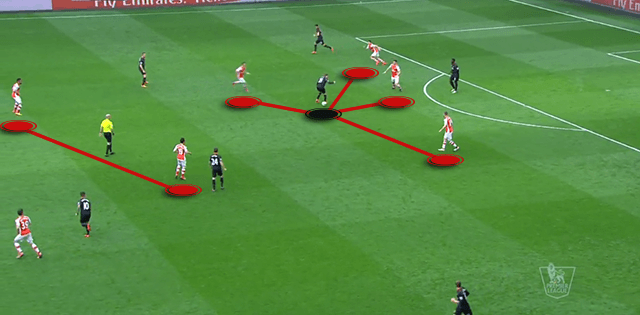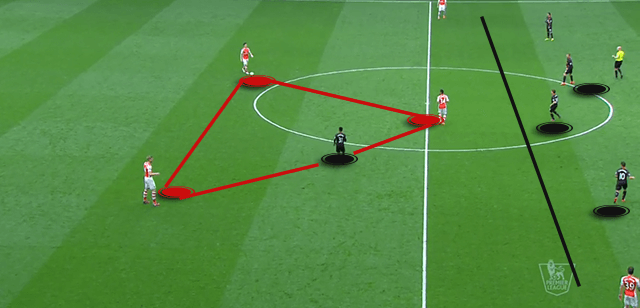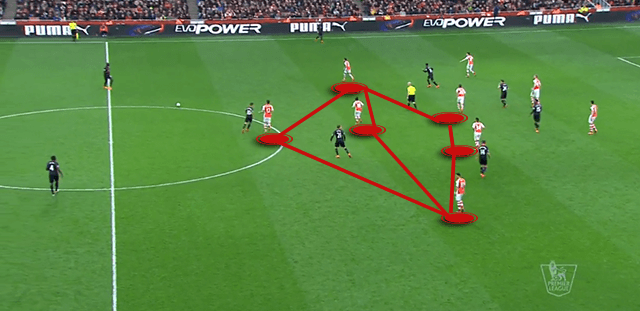Turn your calendars one year back, and you’ll be reminded of a Liverpool master-class, embarrassing an Arsenal side that seemingly had the title in their sights, being undone by intensive high pressing from Brendan Rodgers’ men. While revenge isn’t something an experienced man like Arsene Wenger would spend much time on, the Frenchman sent a message by doing to Liverpool exactly what they did, in a strikingly similar manner.
ARSENAL 4-1 LIVERPOOL

Line-Ups
Arsenal: 13. Ospina; 4. Mertesacker; 6. Koscielny (Gabriel); 18. Monreal; 39. Bellerin; 34. Coquelin; 11. Ozil (Welbeck); 16. Ramsey (Flamini); 19. Cazorla; 17. Sanchez; 12. Giroud
Liverpool: 22. Mignolet; 23. Can; 4. Toure; 17. Sakho; 14. Henderson; 18. Moreno; 21. Lucas; 24. Allen; 10. Coutinho; 50. Markovic (Sturridge); 31. Sterling
Goals: Bellerin, Ozil, Sanchez, Giroud – Henderson
Intensive high pressing
High intensive pressing and quick-fire first half goals in a game between these two sides. Sounds familiar doesn’t it? But the tables were turned at the Emirates, one year on since that game, with Wenger’s men displaying a great show of pressing to displace the opposition.
Arsenal’s decision to play with a four man midfield covered by a defensive midfielder in Francis Coquelin and tipped off with Olivier Giroud allowed the high pressing system to function, without being left too short in the midfield zone. A Liverpool back-line nervous on the ball helped the Arsenal cause, while a two man midfield failed to provide any assurance for the away side.

Arsenal’s increased pressure when Liverpool gained possession saw a flock of men quickly move in. Coquelin did refrain from pressing higher up, allowing the five ahead of him to keep up with the intensity. The ball was recovered by the home side more often than not, though in the instance where the player did manage to wriggle away, he was forced into a backwards pass which ultimately led to a hopeless long ball, while a forward pass created another round of intensive pressure. Arsenal came out with a clear intention of keeping the ball in the opposition half, and did well to ensure this was efficiently conducted.
The initial exchanges saw a tone of disorganization in Arsenal’s pressing, though it remained efficient. A system of pressing wasn’t entirely intact, with the sole intention of regaining possession at all costs. But as the game grew, there was a clear switch to more organized pressing. Wenger seemingly looked to test the waters with an all-out pressing approach early on, before a pre-decided drop to a more controlled system.
The very fact that Arsenal’s pressing and defensive set-up was strangely reminiscent of Liverpool’s in recent games, made the approach all the more interesting. While Rodgers failed to effectively implement the strategy, Wenger took Liverpool’s apparent strength and used it against them.
Difference in off-the-ball setup
With Arsenal’s pressing setting the tone for the game, Liverpool failed to reciprocate when the opposition had possession, naturally falling into a defensive mode realising their inability to mirror the intensity from the home side. Arsenal’s use of creative midfielders was something Rodgers was prepared for, but the pressing that ensued came as a bit of a surprise, forcing the Liverpool boss to push two of his three attackers into wide defensive rolls, pulling the wing-backs further back as well.

While the lack of pressing from Liverpool was a bit disappointing and ultimately the difference, for a brief period in the first half, it allowed Liverpool to get more organised and increase their probability of regaining possession. This was the sole period where Liverpool looked to be at par with their opposition, also forcing Arsenal into their own defensive shift.
But even when the London side toned down the intensity higher up, they ensured the pressing remained intact deeper in the their own half, fully realising the dangers of Philippe Coutinho and Raheem Sterling in attacking areas.

A front two/three often pressured the forward moving centre-backs, with a line of midfielders behind organising themselves for any possession that leaked through the first pressing line. The clear distinction in the two side’s defensive set-ups when not in possession spoke volumes of how the game progressed.
Arsenal thus focused on regaining possession higher up the pitch realising the players’ weakness on the ball, Rodgers responded by not mirroring the intensity but instead containing it with a slower approach. Wenger though quickly gained the upper hand by keeping the pace and intensity levels high even in deeper areas. It was an interesting battle until the individual gulf in class among the players showed as the Arsenal men rewarded Wenger’s approach with three quick goals late in the second half.
The intriguing point to note here though is the difference in the two side’s approach when not in possession, as the game progressed. Arsenal’s intensive pressing in their own half was as effective as Liverpool’s decision to sit back. And as cliche’s go in football, such situations require individual moments of brilliance, Arsenal had three of those (and eventually four).
Arsenal prevent Liverpool from playing through the midfield
A front line of Philippe Coutinho, Lazar Markovic & Raheem Sterling is arguably one of the most fluid attacks in the league, but all three rely on a strength of playing better with space (to varying degrees). Their movement in and around the box, and their ability to move into space is what primarily makes the trio an exciting bunch to watch.
But once that space is not offered, and the option of playing through the middle is rescinded, all three have a clear drop in performance. Realising this weakness, Wenger set out his men to ensure the creativity usually offered failed to materialise, in turn forcing the away side to play the ball into wider areas. With an average height of 5’7″ among the attacking trio, competing against aerially astute defenders in Per Mertesacker and Laurent Koscielny, it was an aerial battle destined to be won by the home side when the crosses did drill in.

Comfortably holding a three goal lead, Wenger set his side out in the second half to ensure that a clean-sheet was maintained, and any chance of a dramatic come-back faded away. Rodgers does know his tactics, and often trusts his players’ ability on the ball, rather than looking at a “Plan B”; occasionally it works as seen against Swansea a couple of weeks back, but in this instance Wenger had Liverpool’s primary attacking outlet contained.
As seen above, Arsenal formed a formidable midfield set-up that focused on preventing the front-line of having possession along the ground through the middle. Even with an aerial threat of Daniel Sturridge, Arsenal were confident in forcing Liverpool into wider areas. Though Liverpool responded with pushing the wing-backs, Alberto Moreno and Emre Can, further ahead, their output still meant Arsenal’s ability to contain the attack with their superiority in the air.
Credit must be delivered to Wenger in this instance, as besides Coquelin, neither of his other midfielders are particularly known for their defensive ability and work rate. But the Frenchman got his attacking minded players in Sanchez, Cazorla etc to display an intensive work-rate in their pressing approach, but always mature professionalism in their organisation to contain the middle area.
A game of individuals
While tactically the battle did intrigue viewers, the game was ultimately won by moments of individual brilliance (and errors). Hector Bellerin’s impressive show of composure, Mesut Ozil’s classy ‘practiced’ free-kick, Alexis Sanchez’ unstoppable shot and Olivier Giroud’s icing on the cake all were special in their own way, managed primarily by individual class. But almost all four moments of magic had reciprocal individual errors from the Liverpool defence.
The opening goal was created and finished by Arsenal’s Spanish youngster, Hector Bellerin, though his countryman on the receiving end would have to shoulder blame. After Bellerin showed great determination in making the ground up an receive the pass, it was Moreno’s slight movement that showed the goal-scorer the side he wanted to move into.

Given the space Bellerin had to work into and get his shot off, the simple response from Moreno should have been to show him into the right channel where the combined pressure of the wing-back and Mamadou Sakho would have resulted in an easy recovery of possession. On most occasions, Bellerin too would have opted for that route; but bursting with confidence and composure, along-with the option offered from Moreno, it was a tempting chance to take.

Olivier Giroud’s 4th goal also resulted from individual errors; while Moreno has received blame for allowing Giroud to move into the space comfortably, it was Sakho who moved ahead (as he often did), to create that space capitalized on by the striker. The French defender was guilty for the second as well, having conceded a needless free-kick.
But it wasn’t just specific moments leading to goals that let Liverpool down. The match was categorised by simple errors that prevented a fluid display as we have recently seen from a Rodgers side. Being easily dispossessed by the Arsenal pressing, and further misplaced passes allowed Arsenal to have possession more often than they would have.

Interceptions (Arsenal = Red, Liverpool = Yellow) | via Squawka
Arsenal comfortably continued to win the midfield battle with their own pressing and errors from Liverpool, but further found joy in recovering possession out wide, an area they forced the away side to play into.
Liverpool’s choice of midfielders
Though Rodgers’ hand was forced, of sorts, given Steven Gerrard’s suspension and Adam Lallana’s injury, the choice of midfielders ultimately came back to effect the result. Using Lucas Leiva and Joe Allen had it’s obvious defensive objective, the lack of any creative talent from midfield, compiled with the defenders’ lack of comfort on the ball meant that the away side failed to produce any real meaningful opportunity.
Liverpool’s most effective midfielder this season, Jordan Henderson, was forced into a wing-back role, one that has become increasingly worrying as the season has progressed. But having pulled the captain onto the wider side meant that there was a further lack of creative displays from midfield, and an increased lack of options up ahead.
Neither Lucas, nor Allen, provide any attacking threat, creative or otherwise, while their passing comprises of lateral passes as opposed to forward ones. This further forced the likes of Coutinho, Sterling and eventually Sturridge to drop into deeper roles.
Where does this leave them?
A season that started disappointingly for both sides until it converged to a point where both seemed like potential direct competitors a few weeks back, the scenario has drastically changed after this result. Though the title may well be out of Arsenal’s clutches, the opportunity to finish 2nd (a first in a decade) still exists. For Liverpool though, a season’s objective of finishing in the top four is almost certainly out of question, and another potential summer of transition is set to ensue.
Written by Sami Faizullah


























































